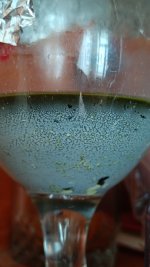Quetzal7
Esteemed member
Preminilary restults of a side to side experiment :
I divided the solvent in 3
- one at room temp
- one with fridge rest and decant
- one with fridge rest , then mixed with 1% sodium carbonate for 10 min
I did the procedure with 3 batches of different cactus (so 9 jars of solvent in total) ; the batches were a bit too small to give an accurate answer if it affected the yield. Visual analisis said there was not much difference, but the one dried with sodium carbonate had a more sticky, slightly "goey" layer on the bottom of the jar, and possibly a lower yield.
I thought it could have to do with some sodium carbonate particle that didn't get decanted/filtered properly, and messing around the crystalization process , or of course , because of not enough moisture for the reaction to occur properly.
I have a couple more test to do, as i'm not yet sure why sometime i succeed and sometimes not ; i will report when all my data is organized and compiled
But moisture content doesn't seems to be the critical parameter
The parameters that i want to investigate : quality of the lime , time since i mixed the lime (i made an extract with a batch of lime made the day before, and it the consistency was super sticky ; but it was different cactus too so i'm not sure...) , type of citric acid (i have anhydrous and 1-h, i will do a side to side to see if it changes anything).
I think, used solvent VS fresh solvent has been tested, right ? and that didn't changed anything if i remember ?
I divided the solvent in 3
- one at room temp
- one with fridge rest and decant
- one with fridge rest , then mixed with 1% sodium carbonate for 10 min
I did the procedure with 3 batches of different cactus (so 9 jars of solvent in total) ; the batches were a bit too small to give an accurate answer if it affected the yield. Visual analisis said there was not much difference, but the one dried with sodium carbonate had a more sticky, slightly "goey" layer on the bottom of the jar, and possibly a lower yield.
I thought it could have to do with some sodium carbonate particle that didn't get decanted/filtered properly, and messing around the crystalization process , or of course , because of not enough moisture for the reaction to occur properly.
I have a couple more test to do, as i'm not yet sure why sometime i succeed and sometimes not ; i will report when all my data is organized and compiled
But moisture content doesn't seems to be the critical parameter
The parameters that i want to investigate : quality of the lime , time since i mixed the lime (i made an extract with a batch of lime made the day before, and it the consistency was super sticky ; but it was different cactus too so i'm not sure...) , type of citric acid (i have anhydrous and 1-h, i will do a side to side to see if it changes anything).
I think, used solvent VS fresh solvent has been tested, right ? and that didn't changed anything if i remember ?

